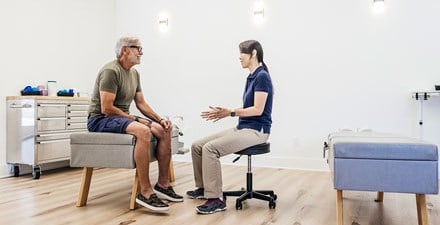
There are many benefits to exercise. Physical activity can improve your physical, mental, and social health. Exercise can improve sleep and help you maintain strong muscles and bones. It also can help prevent or improve many chronic conditions, such as heart disease, diabetes, obesity, depression, and some cancers.
When you exercise, you are putting healthy stress on your heart, lungs, muscles, and bones to gain strength or endurance. This good stress can cause normal muscle soreness and fatigue. It's a sign that you did something to improve your health and strength.
The good news is that normal soreness after a workout is not a cause for concern. Soreness should go away on its own after a few days. But pain or discomfort that lasts may mean you have an injury.
Here's how to tell the difference between muscle soreness and pain, plus some tips from a physical therapist for managing both.
Muscle Soreness
Exercise soreness sometimes results from starting to use muscles that you have not used stressfully in a long time. This is called delayed onset muscle soreness, or DOMS. This soreness is a result of small, unharmful "tearing/stress" on these unused muscle fibers. The great part is, as the body repairs these small tears, muscles become stronger. Short-term muscle soreness is a healthy and expected result of exercise. Normal muscle soreness and fatigue peak between 24 and 72 hours after a muscle-stressing activity. It should go away on its own after a few days.
The amount of soreness you have will depends on the time and intensity of your exercise. It also will depend on whether the activity was new to you and how intense your workout was. It can take longer for your body to adapt to new activities. This is especially true for more intense activities that are longer or use movements you are not used to doing.
What To Do if You Have Muscle Soreness
During the recovery period, while you have soreness, it is important to:
- Give the muscles you worked time to recover.
You are more likely to get injured if you continue with the same intensity and type of exercise too soon. More intense and lengthy activities, such as running a marathon, can take over a month to fully recover. - Stay active and keep moving until the soreness decreases or goes away.
DOMS often improves with easy stretching and light movement. Total rest can increase soreness. While you recover, consider doing a different exercise. Or do your activity at a lower intensity or for less time during the first few days of soreness. - Vary your activities.
Work your legs, arms, and whole body on alternate days. This will help you keep moving and strengthen other muscles while allowing the sore ones to rest.
Pain
Injury pain usually occurs in a specific body part, like a tendon or a joint. It can be more intense and more constant than muscle soreness. It may vary from a constant "ache" (even without movement) or you may feel sharp pain during movement or exercise, or afterward with a particular movement. It can keep you awake at night. With pain, your joints or muscles may become very stiff if you rest or sit for a long time. Injury pain may not go away on its own.
Pain also can change how you move. If you limp because of pain or favor one shoulder over the other, it may be a sign of an injury.
What To Do if You Have Pain
- Stop any painful activities and change what you do.
Ice can provide short-term relief for pain caused by inflammation. - Don't push through the pain.
Pushing through pain can cause the problem to get worse and lead to further injury. - Seek help from a health care provider.
If you have pain that doesn't go away, even after seven to 10 days, see your doctor or physical therapist for an evaluation and treatment. The American Physical Therapy Association offers a tool called Find a PT to help you search a national database of physical therapist members.
Pain is personal, and the degree of injury does not always equal the amount of pain you feel. Here are nine things you should understand about pain .
The CDC recommends safe alternatives like physical therapy over opioids to manage pain. Learn more about safe pain management .
Consult the handy chart below for an overview and recap on the difference between muscle soreness and pain.
How To Make Progress
Your body needs to do more than usual to make physical improvements. But you should make sure to increase your physical activity and exercise safely and slowly over time.
Each person has a different capacity to do sports and exercise. This is called an activity threshold. When you stay within a safe activity threshold, you should only experience normal muscle soreness. Each person's activity threshold depends upon many factors, such as:
- Age.
- Technique.
- How strong you are.
- Your regular activity levels.
For example, when a person first begins a walking or running program, a safe activity threshold may be walking or running for five minutes. After several weeks of slow, progressive increases in duration, the safe threshold may increase to 20-30 minutes. Going beyond the safe activity threshold too soon can result in an injury or pain.
To improve your activity threshold and overall fitness safely, make sure you:
- Only add new activities or increase your intensity, distance, speed, or resistance (weight) little by little. Too much too soon is a recipe for injury.
- Start back slowly after time away from a sport or activity. If you return to an activity after an injury or time off, your activity threshold may be lower. Don't try to restart the activity at your previous level right away. Work toward a gradual return to the intensity, distance, and duration of exercise you reached before taking a break.
- Give your muscles time to recover between intense activities. You will get more benefits with slow, steady progress than from pushing yourself too hard too quickly.
How Can a Physical Therapist Help?
Even if you don't have an injury, a physical therapist can assess your strengths and weaknesses. They can work with you to improve your performance in your sport or activity. They will develop a safe, progressive exercise program to help you reach your goals and teach you ways to prevent injuries.
If you have pain caused by an injury, a physical therapist can help you recover. They also will recommend activities to help you keep your fitness and help you address any weaknesses or movement problems that contributed to your injury.
Physical therapists are movement experts who diagnose and treat movement problems. They help people address and manage pain and improve quality of life through hands-on care, patient education, and prescribed movement. You can contact a physical therapist directly for an evaluation. To find a physical therapist in your area, visit Find a PT.
Muscle Soreness vs. Pain Chart: At a Glance
| Muscle Soreness | Pain | |
|---|---|---|
|
Soreness or pain |
Muscles are tender to touch, tired, or you have a burning feeling while exercising. Your muscles may feel a dull ache, tight, and achy feeling when you try to use them. This may also be present at rest but is more common when you try to use them. |
Pain causes an ache or sharp pain at rest or pain when exercising. May be more constant than muscle soreness. |
|
Onset |
During exercise or 24-72 hours after the activity |
During exercise or within 24 hours of activity |
|
Duration |
Two to three days |
May not go away without treatment |
|
Location |
Muscles |
Muscles, tendons, or joints |
|
Improves with |
Stretching and continued light movement. Rest and recovery time vary. |
Ice, rest, and appropriate or prescribed movement |
|
Worsens with |
Sitting still or being fully inactive |
Continuing the aggravating activity, even after appropriate rest and recovery |
|
What to do |
Get moving again after appropriate rest and recovery, but consider doing a different activity until the soreness is gone before resuming the activity or intensity that led to soreness. |
Consult with a doctor or physical therapist if the pain is extreme or lasts for more than 10 days. |


